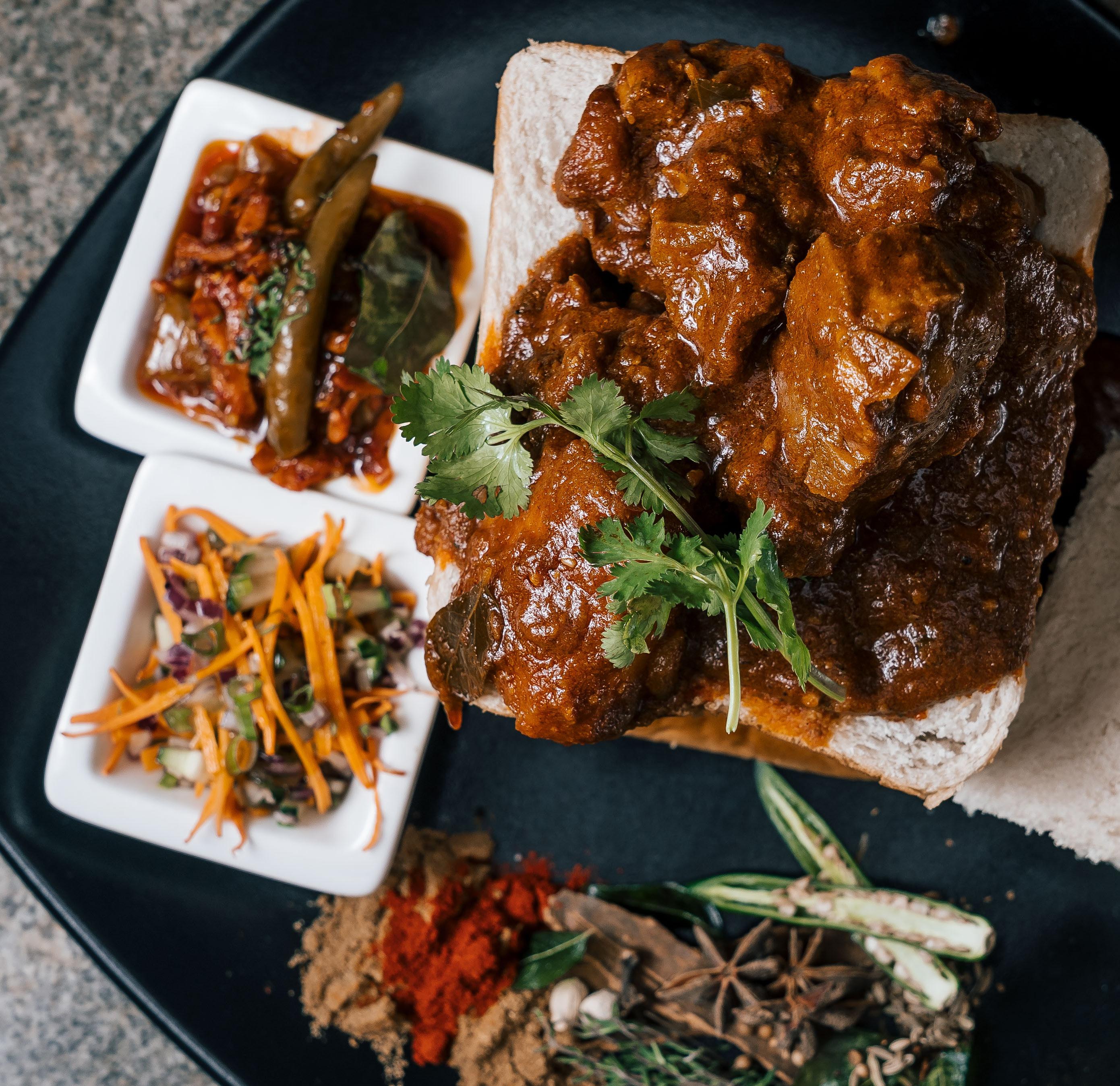
26 minute read
The best of local township cuisine
NATHAN ADAMS & LUTHO PASIYA
Mutton Curry Bunny Chow
Advertisement
The bunny chow represents the fabric of South Africa’s rich and colourful heritage. You can leave out the meat if you are vegetarian.
Ingredients:
400ml cooking oil 500g onions, finely chopped 40g fresh ground ginger 40g fresh ground garlic 60g mix masala 30g Garam masala 2g turmeric powder 2kg mutton, salt to taste 500g red ripe jam tomato, puréed 20g finely chopped coriander 10g finely chopped curry leaf 4 potatoes cut in quarters
Method: Braise onion in oil until light golden brown. Add ginger or garlic paste. Add masalas and turmeric and stir, then add washed and drained meat. Stir until meat is well coated. Add salt and allow masala to “fry” on a low heat with the meat for at least 10 minutes, mixing regularly without burning masala spices. Add tomato, chopped coriander, chopped curry leaf, water and allow to cook. When meat is almost soft add the potatoes and a bit of water. Allow to cook on medium to low heat until potatoes and meat are cooked. Check salt and garnish with fine chopped coriander. Serve in a quarter loaf and enjoy.
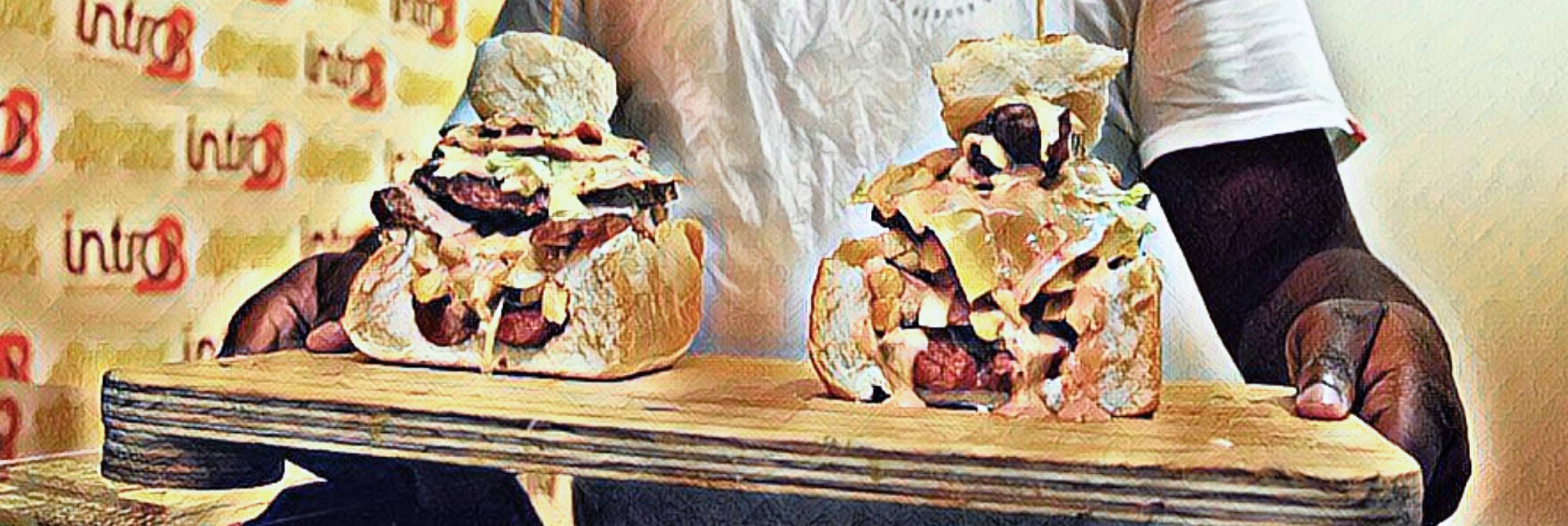
Made from a quarter of a loaf of bread and a large variety of meaty fillings, it has to be one of the perfect fast food meals to get your tummy full. The bread is hollowed out, filled first with a layer of seasoned hot chips, then topped with optional layers of sauce, cheese, egg, and meat.
Ingredients: Quarter of bread Masala Steak Gatsby With Gherkins And Pickled Onions
Ingredients:
Steak 1 tbs steak and chops spice 1 tsp traditional roasted masala 700g-800g tenderised minute steaks canola oil to fry 2 tbs butter or margarine Fried potato chips 1 Russian sausage Sauce (any sauce) Ham or polony Fried onion rings 1 vienna sausage Beef patty or chicken patty or rib patty Cheese 1 egg (optional) Atchar (optional)

Method: Take the quarter of bread and cut out the soft part out into a 150g/½ cup mayonnaise 2 tbs/60g mango atchar 150g-200g lettuce 200g/2 whole tomatoes, sliced 160g/4 gherkins, sliced 80g/4 hot pickled onions, sliced 8 slices cheese 500g deep-fried chips, spiced Steak: Sprinkle the steak and chops spice and masala over the tenderised minute steaks. Heat the oil and the butter in a large frying pan and cook the steaks on high heat, for 1 to 2 square and toast it. In the open space of the bread, put your first layer of fried chips followed by the Russian then add sauce. Thereafter, you can place polony or ham. Add another layer of fried chips and onion rings and drip your sauce again. Add the vienna. Add your beef, chicken or rib patty. Add cheese or fried egg.
Take the small soft piece of bread from the hollowed part and place it on
top. Add Atchar. minutes on each side. Remove the steaks from the frying pan and set aside. Keep the juices. Gatsby: Combine the mayonnaise and mango atchar, and spread on the bottom of the sliced French loaf. Add lettuce, tomato, gherkins, pickled onions and steak in layers, finishing with the cheese slices. Combine the steak juice with deep-fried chips, and evenly scatter on to the gatsby (submarine sandwich). Cover with the top of the French loaf and serve.
The Ultimate Braai Guide
Any South African will tell you that boerewors and sunny skies are the essentials of a proudly African braai. Add tangy potato salad, a couple of juicy steaks and a group of friends to share it with, and you’ve got a recipe for an irresistibly delicious, fun-filled feast! We rounded up the best braai tips ...
MOST South Africans are skilled braaiers. But even so, there’s always an opportunity to improve and become a braai master. So ahead of your braai feast, here are some tips tips to elevate your fire cooking game.
After braaiing, let the steak rest for at least five minutes before slicing, to allow the juices to redistribute evenly and give you a juicier steak.
When turning a steak around on a braai, don’t use a fork, knife or any other sharp object you have managed to get your hands on. When you use a sharp object on the meat, you’re essentially piercing holes into the meat, and this means that it is losing moisture. So use braai tongs… or just use your fingers.
Throw sprigs of fresh herbs such as sage, rosemary or thyme on to your fire. It will give your meat added flavour and make the air smell wonderful.
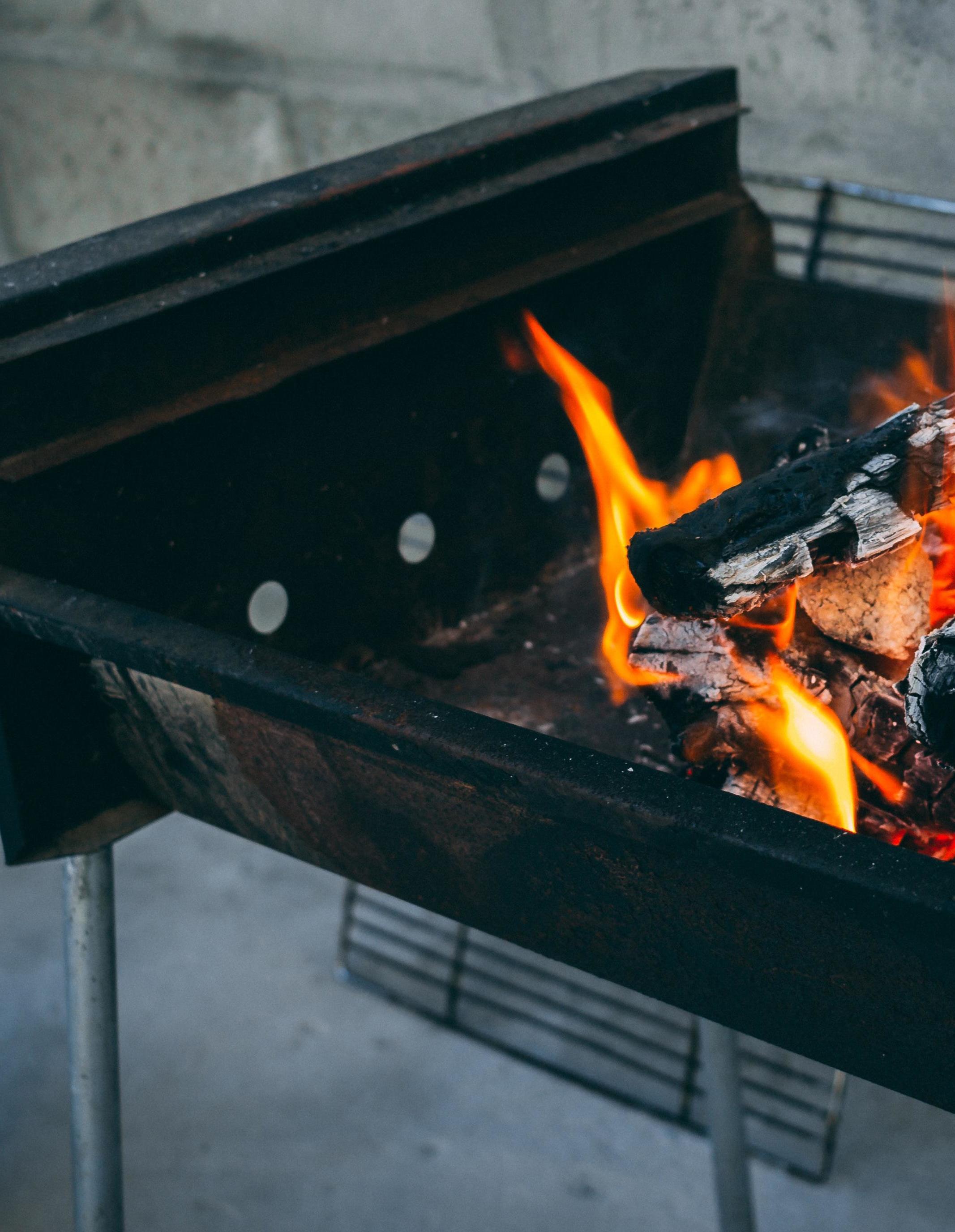
Sprinkle some plain white sugar over the wood and light with firelighters. The sugar burns at a high temperature which helps you increase the internal temperature of the wood, making it easier to braai with.
Rosemary skewers are a great way to infuse extra flavour to your meats, such as lamb and firm fish like monkfish. Drizzle fresh lemon over during cooking, the aroma is truly irresistible.
Pour apple juice into a spray bottle for pork chops or ribs. This adds a great natural sweetness to the meat.
For those who will be skipping out on the red meat and grilling fish this Braai Day, here’s an easy way to prevent it from notoriously sticking to the grill. All you need to do is slice up some lemons, set them on the grill and place the fish on top of the lemon slices, which also adds to the tantalising taste of the fish, and grill as desired. No stick, no fuss!
BAKED CITRUS CAMEMBERT (Serves 4)
Ingredients:
1 whole camembert grated rind of 1 orange grated rind of 1 lemon a few sprigs of lemon thyme 45ml rosé wine
Methods: Pierce holes in the camembert and place in a double layer of foil. Sprinkle over the rinds and thyme. Pour over the wine. Seal well and place on the braai for 5 minutes until melted and oozing.

GRILLED HALOUMI BRUSCHETTA (Serves 6)
Ingredients:
30ml lemon juice 60ml olive oil 30ml chopped fresh mint leaves 5ml chopped garlic salt and pepper 300g haloumi, cut into 5mm slices 2 tomatoes, sliced 1 ciabatta bread, sliced ready-made pesto
Method: In a bowl, combine the lemon juice, oil, mint, garlic, and salt and pepper. Add the sliced haloumi and marinate for 30 minutes. Prepare the braai. On a hot grid, cook the haloumi until golden on both sides. Cook the tomatoes a few seconds a side. Brush the ciabatta slices with olive oil and cook until golden on either side. Arrange the ciabatta on a serving board, followed by a slice of tomato, and then the haloumi. Drizzle with pesto and serve.
CHICKEN ESPETADA (Serves 8-10)
Ingredients:
125ml olive oil 30ml red wine vinegar 30ml dry sherry 1 red chilli, seeded and chopped 10ml chopped garlic 10ml dried thyme 5ml salt 5ml ground black pepper 6-8 bay leaves 8-10 chicken thighs trimmed of excess fat
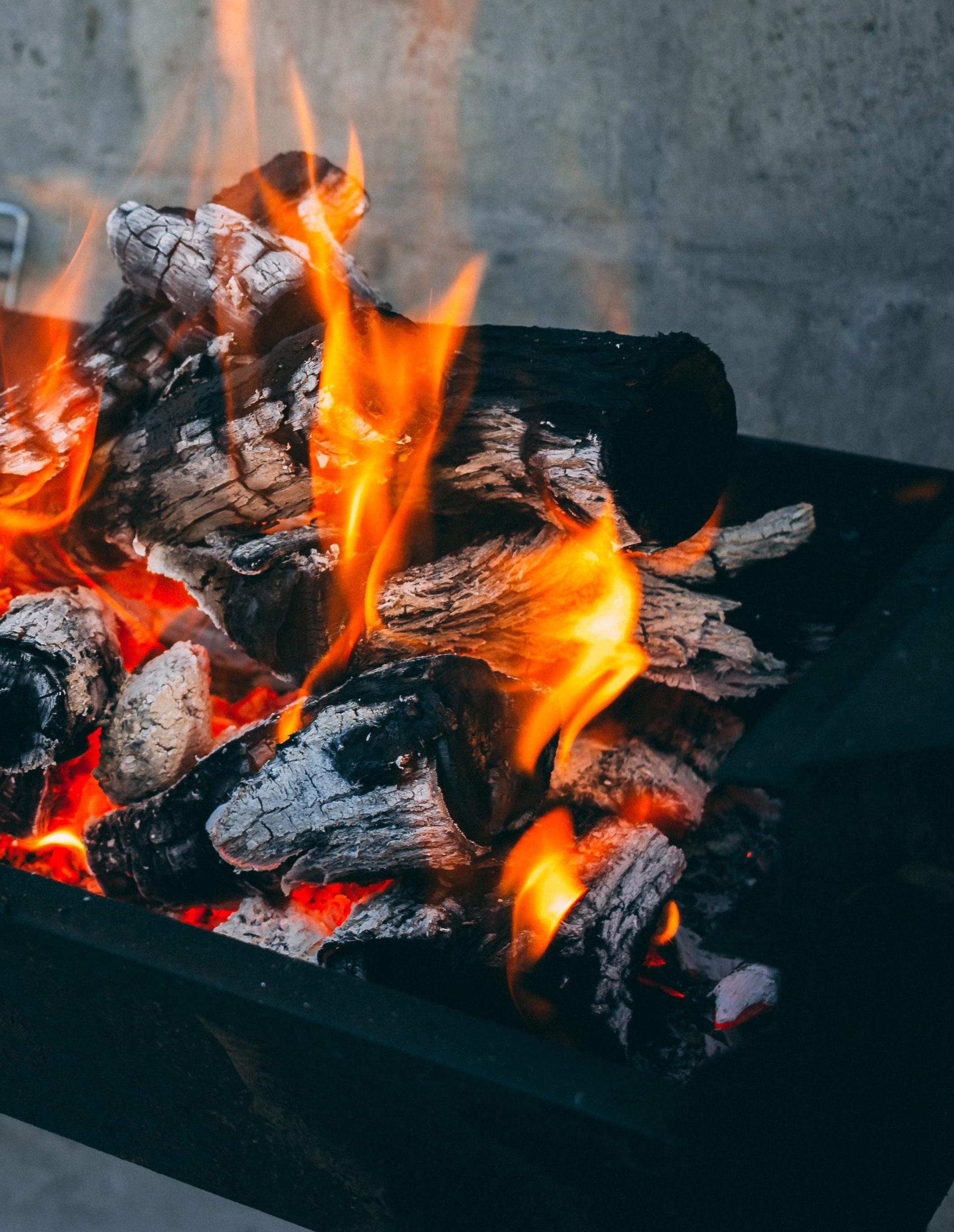
Method: Combine all the ingredients for the marinade and mix well. Pour over the chicken thighs. Refrigerate for a few hours or overnight. Thread the thighs on to soaked wooden skewers or metal ones. If you have a bay tree, the chicken can be skewered on to cleaned branches. Prepare a hot fire and cook the skewers over indirect heat with the lid on for 30-40 minutes until well cooked. Base with any remaining marinade. Delicious served with Portuguese rolls.
BRINJAL ROLLS (Serves 4-6)
Ingredients:
1 onion, peeled and chopped 45ml olive oil 5ml chopped garlic 400g tin of chopped tomatoes 30ml tomato paste 60ml chopped fresh basil salt and pepper 3 medium brinjals 60g pitted black olives, chopped 125ml grated Mozzarella
Method: Fry the onion for a few minutes in 15ml of the oil. Add the garlic and cook for five minutes. Stir in the tomatoes, paste and half the basil and simmer, uncovered, for 10-15 minutes until thickened. Season to taste. Cut each brinjal into 5 or 6 slices, lengthways. Pick out the largest 12 slices. Brush on both sides with oil and grill on the braai in batches until browned. Set aside. Grill the rest, then chop them and put them in a bowl. Add the olives. Add 60ml of the cooked tomato sauce to the chopped brinjals and olive mixture and stir. Spoon half of the rest of the tomato sauce into an ovenproof dish. Preheat oven to 200°C. Divide the filling between the brinjal slices. Sprinkle each with Mozzarella and basil. Roll each slice up. Pack them in the dish, seam-side down. Spoon the rest of the sauce over and sprinkle with the rest of the Mozzarella. Bake for 15 to 20 minutes, until heated through and the cheese is melted.
The Ultimate Braai Guide
BUHLE MBONAMBI & LUTHO PASIYA
Olive-butter braai Mielies
Ingredients:
1/3 cup (80ml) softened butter 3 Tbsp (45ml) olive tapenade 4-5 corn on the cob

Method: Remove the husks from the corn on the cob. Simmer in water for about 10-12 minutes or until cooked through. Mix softened butter with olive tapenade and set aside. Place corn over medium coals for a few minutes, or until slightly charred. Serve with spoonful of flavoured butter.
BBQ Ribs
Ingredients: 125ml tomato sauce 125ml chutney 60ml Worcestershire sauce 30ml sweet chilli sauce 15ml brown sugar 5ml chopped garlic 10ml English mustard powder salt and pepper 2kg ribs


Mix all the ingredients together and stir to combine. Pour the marinade over the ribs and allow to stand for an hour or overnight. Braai over red hot coals for about 10 minutes per side, turning and basting with the leftover marinade, until done as desired.
Vegetable and halloumi skewers
Ingredients:
4-5 courgettes, thickly sliced 250g whole button mushrooms 250g cocktail tomatoes 1-2 red and yellow peppers, cut into cubes 250g halloumi cheese, cubed soaked wooden skewers
Basting sauce:
60ml olive oil 30ml lemon juice 5ml Dijon mustard 5ml chopped garlic salt and pepper 15ml chopped thyme 15ml chopped rosemary
Method: Thread the vegetables and halloumi alternately on to soaked skewers. Cook over hot coals, basting frequently, until vegetables are cooked and cheese is soft and slightly charred. Serve immediately.
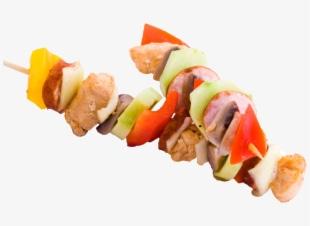
Braai Rump
2 Extra thick or 4 regular rump steaks
For Marinade:
80ml sweet chilli sauce 10ml chopped garlic 10ml grated ginger 30ml fish sauce 60ml lime juice 60ml chopped coriander 10ml sesame oil
Cucumber salad Ingredients:
4-5 small pickling cucumbers 80ml sugar 160ml white wine vinegar 1 small fennel bulb, chopped 1 red chilli, seeded and sliced thinly, 60ml peanuts, roasted and chopped, 30ml chopped coriander
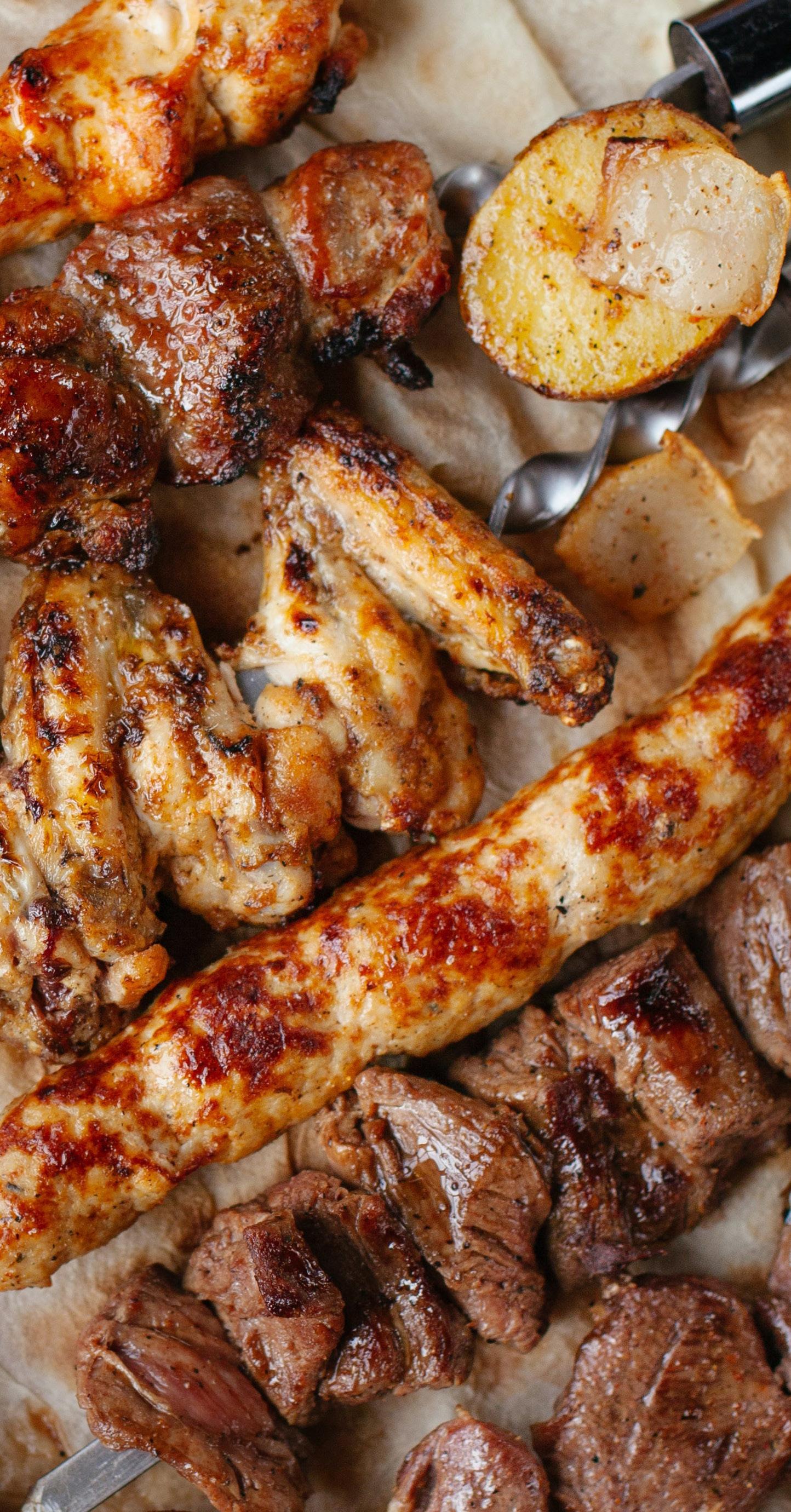
Method: Place the steaks in a shallow dish. Combine all the ingredients for the marinade and pour over the steaks. Refrigerate for 30 minutes. Braai over medium coals for 10 minutes a side, basting occasionally. Remove, cover with tinfoil and allow to rest for 10 minutes before carving. Serve with the salsa.
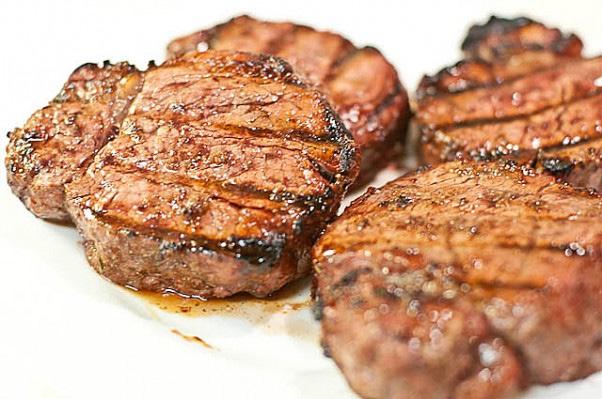
Thai Mussel Parcel
Ingredients:
1kg half-shell mussels 2cm piece of ginger, peeled and grated 2 garlic cloves, crushed 1 chilli, de-seeded and finely chopped juice and grated zest of 1 lemon and 1 lime salt and pepper 400g tin of coconut milk 1 stalk of lemongrass, bruised 125ml chopped coriander
Method: Place the mussels in a plastic bag. Add in the ginger, garlic, chilli, and lemon and lime juice and zest. Season with salt and pepper. Shake the bag to coat all the mussels. Allow to marinate for 30 minutes. Meanwhile, heat the coconut milk and lemongrass in a pot and simmer for 15-20 minutes, until reduced and slightly thickened. Remove and cool. Discard the lemongrass. Cut two large pieces of tinfoil and place on the work surface. Place the mussels into the middle. Pour the coconut milk evenly over the mussels. Fold the edges of tinfoil over the mussels and press the edges firmly together to seal. Place on a hot braai, cover with the lid and cook for 10 minutes, until heated through and bubbling. Remove and serve in the tinfoil parcel sprinkled with coriander.
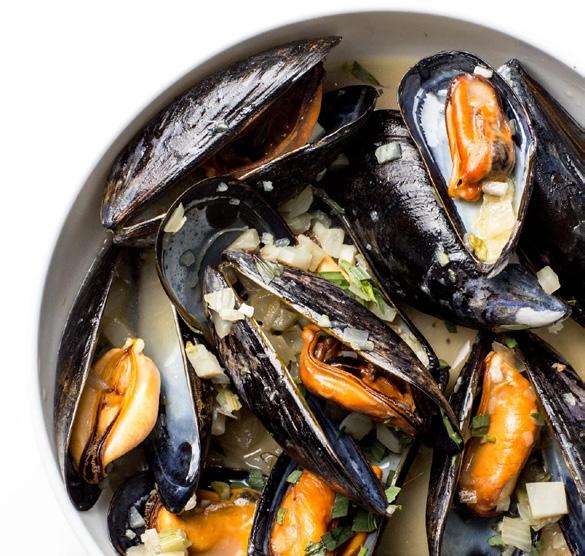
Ingredients:
Some organic sweetcorn 1 onion, finely chopped 1 chilli, de-seeded and chopped 1 garlic clove, finely chopped 5 tsp of cooking oil 360g Maize Meal (3 cups), 1 chicken stock 1 tsp salt 1 tsp chopped chives 3 tsp butter 100g grated cheddar cheese Cornflour, for dusting
Method: Char-grill the corn ears over a hot grill until cooked. Cut the kernels from the cob and set aside to rub or roll the maize balls in. Grease an oven dish and line with greaseproof paper. In a large pot, fry onion, garlic and chilli in oil for 2 minutes over high heat. Add white wine and boil for about 3 minutes.
Add maize meal and stir. While at it, add 2 cups of chicken stock and continue stirring. When it has mixed well, add another 2 cups of chicken stock while stirring. Reduce the heat to medium and continue cooking while stirring for about 5 minutes. Add the salt and the reserved corn kernels and stir through. Remove from the heat. Add chopped chives, butter and cheddar cheese. Stir vigorously to melt the butter and cheese without allowing the mixture to split.
Cook the pap normally and cut into small balls or roll it once cold. Transfer the mixture and roll in the corn. Cover with a piece of buttered greaseproof paper and refrigerate for at least 2 hours. Preheat the oven to 200°C. Heat 3 tbs of oil in a large frying or griddle pan until smoking hot.
Gently fry the dusted squares on both sides until golden and crispy. Transfer back to the oven dish and place in the preheated oven for 4-7 minutes until heated through.
SA’s national dish?
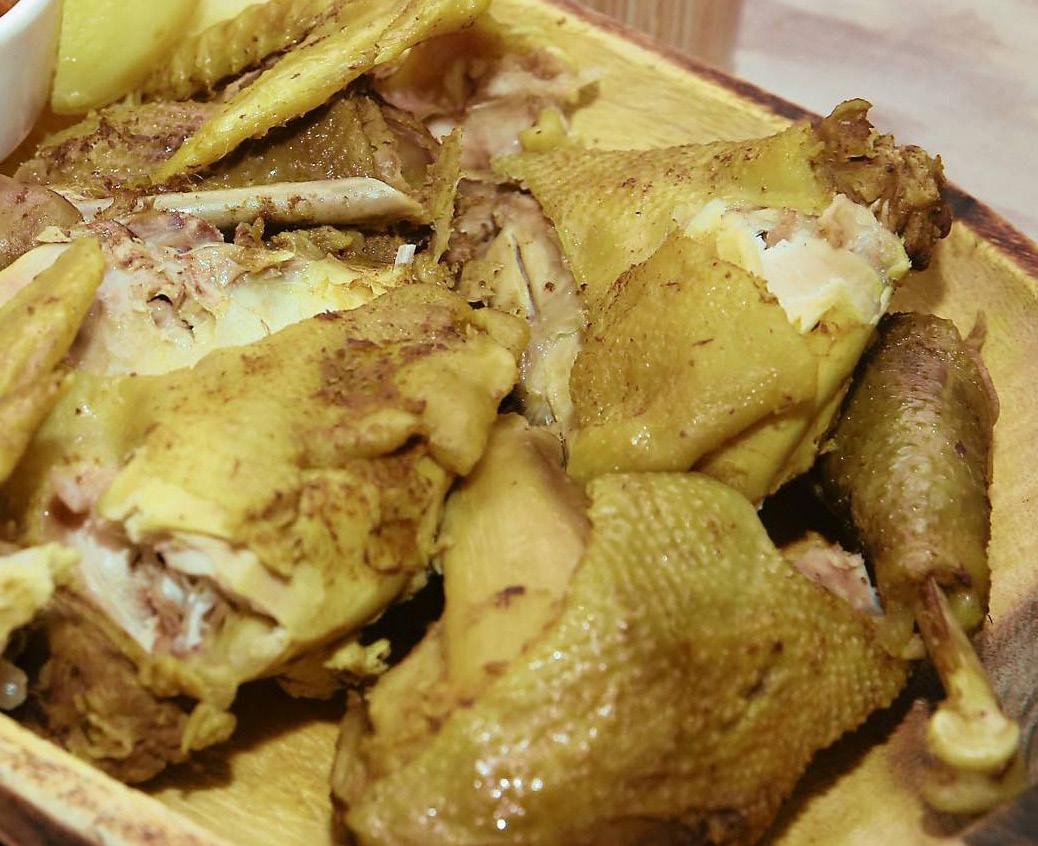
BY BUHLE MBONAMBI Does South Africa have a national dish? Is there one particular dish that you can only get in South Africa and is the first thing you think of when someone mentions South African cuisine? We have gone with two universal favourites, umleqwa (boiled chicken), which was Madiba’s favourite meal and lamb akhni, which is not the same as breyani...
Umleqwa (hard–body chicken) Serves 4
Madiba loved this dish and so do many of us. No family gathering in the township is complete without some hard body chicken. You can have it with jeqe, pap and with a spicy relish, like chakalaka, which will bring that kick the chicken needs to taste even better.
Ingredients:
1½ kg chicken (farm is best but otherwise free range), cut into pieces 1 onion, chopped 1 tbsp flour 3 cups (750ml) chicken stock chopped fresh parsley to serve minutes with the lid off; the water will evaporate. Allow the chicken to slightly fry in its own fat for a further 5 minutes. Add the onion and the flour, and cook for another few minutes. Stir in the stock, bring to the boil and cover. Cover for 20-25 minutes until the chicken has cooked through Scatter with parsley, and serve with the sauce on the side
Salwaa’s Lamb / Mutton Akhni
Salwaa Smith, Cape Malay Cooking & Other Delights
Ingredients:
1kg lamb/mutton pieces 6 medium potatoes, peeled and halved 1 heaped tsp saffron (optional) 250ml (1 cup) boiling water 3 large onions, finely chopped 15ml (1 tbs) butter or margarine 250ml (1 cup) buttermilk 1 large whole fresh green chilli, slit open 15ml (1 tbs) garlic and ginger paste 125ml (½ cup) chopped fresh dhania 12.5ml (2½ tsp) salt, to taste 12.50ml (2½ tsp) red leaf masala 10ml (2 tsp) ground jeera 5ml (1 tsp) chilli powder 10ml (2 tsp) turmeric 1kg basmati rice 125ml (½ cup) oil 7.5ml (1½ tsp) jeera seeds 5ml (1 tsp) mustard seeds 2 bay leaves 6 cardamom pods, slit open 4 pieces of stick cinnamon 60ml (¼ cup) water
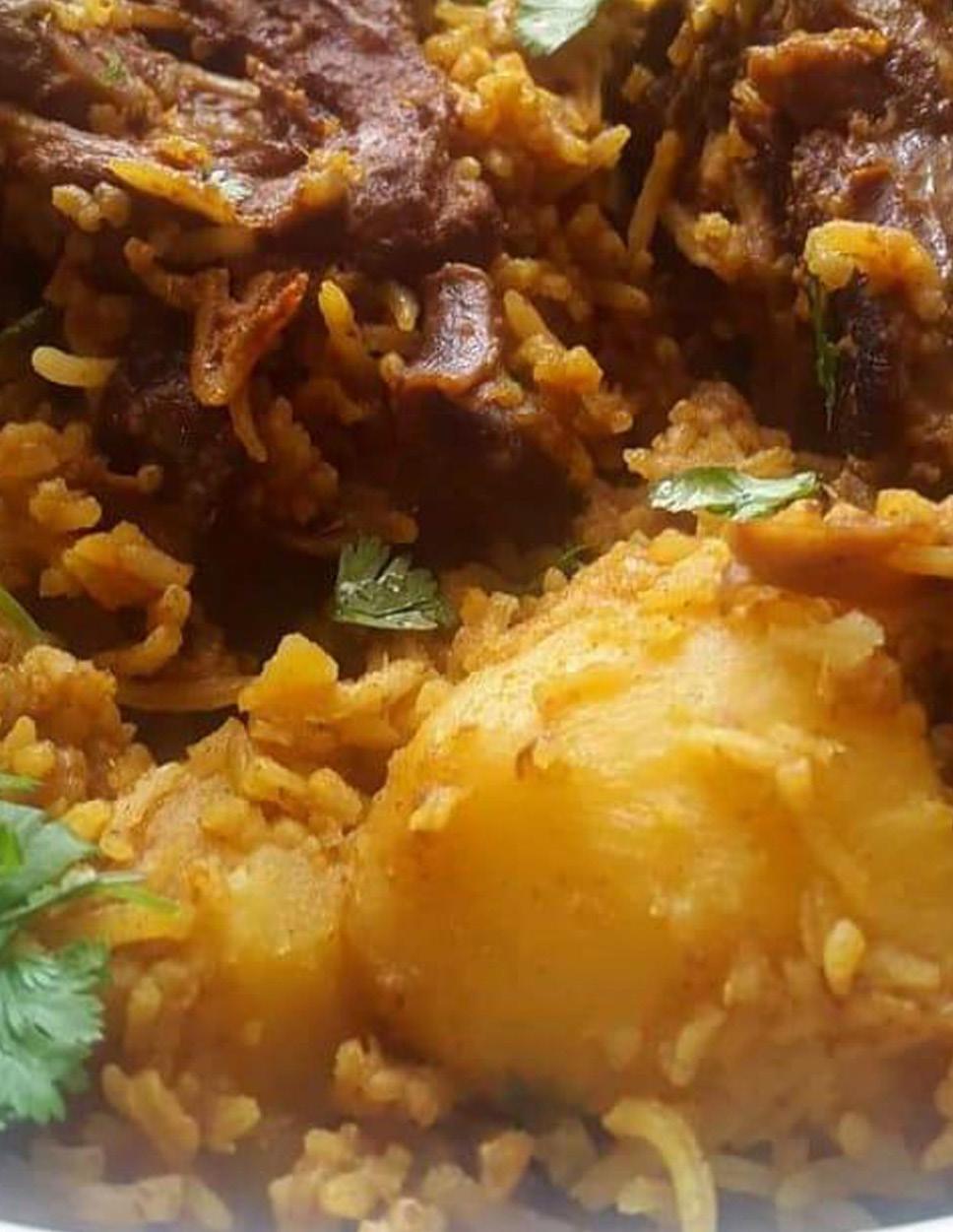
Method: Wash the lamb/mutton, drain and set aside. Boil potatoes in water, with salt to taste, until half-cooked and still firm. Infuse the saffron in the boiling water and set aside. Pan-fry 1 chopped onion in 15ml (1 tbs) of the butter and set aside. Place the mutton pieces in a large mixing bowl and add the buttermilk, green chilli, garlic and ginger paste, dhania, salt, red leaf masala, ground jeera, chilli powder and turmeric. Mix thoroughly, ensuring that all the mutton pieces are covered in the marinade. Set aside for 1 hour. Rinse the rice in a colander, drain and place in a large pot on medium to high heat. Add water to reach halfway and add 45ml (3 tbs) salt. Boil till half-cooked (the rice grains should be firm). Transfer to a colander and rinse under cold running water. Drain and set aside. To a large pot on medium to high heat, add the oil and heat. Add the remaining onions along with the jeera seeds, mustard seeds, bay leaves, cardamom seeds and cinnamon, and braise till golden. Add the marinated meat and the marinade, the 60ml (¼ cup) of water and simmer on medium heat for about 30 minutes, or till the meat is tender and cooked. Arrange the potatoes between the meat pieces and spoon the rice on top. Pour the fried onion with the melted butter over the rice, and pour the cup of water containing saffron over the rice and onions. Steam, covered, for 35 minutes. Remove from the heat and serve with dhai and tomato and onion salad. Note: All akhnis and breyanis should be dished from the bottom up.
South Africans love sweet things – we sweeten veggie dishes, we love barbecue sauce on meat and one of our puddings has its own day. BY LUTHO PASIYA
Melktert with Sea-salted Caramel Apples and Pears
Ingredients:
225g plain flour ½ tsp salt 110g chilled butter, cut into pieces 2 tsp castor sugar 1 egg yolk Chilled water, to mix
Filling:
300g low-fat soft cheese 50g castor sugar 1 tsp vanilla extract 300ml single cream 2 large eggs Icing sugar, for sprinkling
Topping:
30g butter 30g castor sugar 1 apple, cored and thinly sliced 1 pear, cored and thinly sliced Generous pinch of sea salt
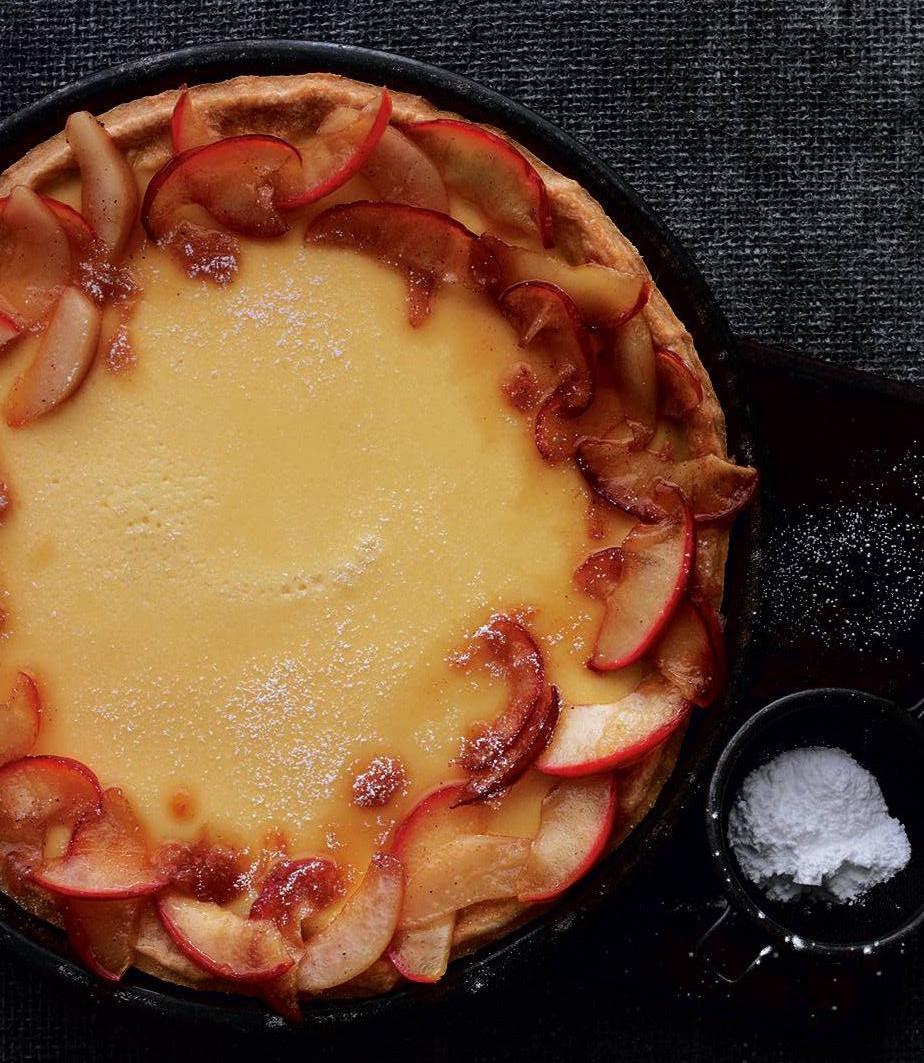
Method: Preheat the oven to 180°C/Gas Mark 6. Sift flour and salt together. Rub in the butter until the mixture resembles fine crumbs. Add sugar, egg yolk and enough chilled water to make a smooth (not sticky) dough. Wrap and chill for 10-15 minutes.
Roll out pastry on lightly floured surface and use to line a 25cm flan ring or dish. Line with baking paper and baking beans or crumpled foil. Bake blind (without a filling) for 10 minutes. Reduce the oven heat to 180°C/Fan 160°C/Gas Mark 4. Beat together the low fat soft cheese, sugar, vanilla extract, single cream and eggs. Remove baking paper and beans/ foil from pastry case. Pour in the filling and bake for 25- 30 minutes, until set. Cool.
For the topping, melt the butter in a frying pan and add the castor sugar, cooking for a few moments to dissolve it.
Add the apple and pear slices and cook, stirring occasionally, for 4-5 minutes, until tender and beginning to caramelise. Add the sea salt, cool slightly, then spoon on top of the tart.
L o c a l D e s s e r t s
Ingredients:
Serves 6 500ml (2 cups cream) 1 x 385g Nestle Caramel Treat 3 x 35g bars Nestle Peppermint Crisp chocolate, chopped peppermint essence (optional) 1 x 200g packet Bakers Tennis Biscuits
Method: Whip the cream until stiff peaks form. Gently fold in the caramel and two-thirds of the chocolate. Add a few drops of peppermint essence. Layer the biscuits in a square or rectangular dish. Spoon the cream mixture on top of the biscuits and sprinkle the chocolate on top. Chill in the fridge for 2 hours, or until set.
Indian Payasam
Ingredients:
2 cinnamon sticks 3 cardamom pods 1 cup vermicelli, broken 110g butter 1 litre full cream milk ½ cup sago 2 tbs sugar (according to taste) 2 tbs condensed milk 100g flaked almonds, toasted 100ml cold water
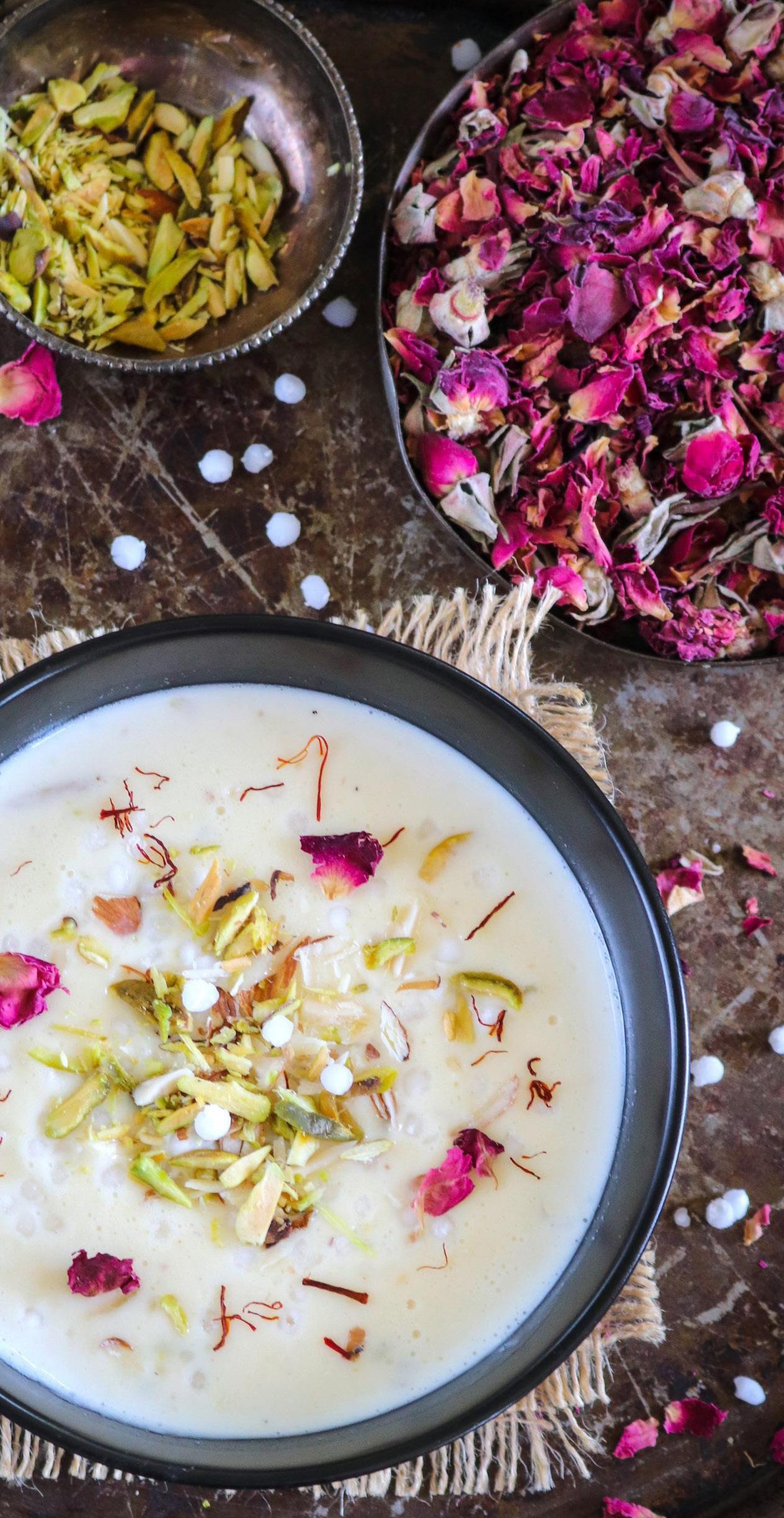
Method: Soak the sago in the cold water. Place the cinnamon sticks and cardamom pods into a pot and roast on low heat. Add the vermicelli and stir until light golden brown. Don’t burn. Add the butter and stir for a minute. Then add the milk. Drain the sago and add to pot. Simmer on a low heat until the vermicelli softens and the sago looks like tiny, glass beads. Mix will thicken. You may add more milk if it gets too thick. Once the vermicelli is cooked, add the sugar. Once the payasum is cooked, remove from heat and stir in the condensed milk for extra creaminess. Garnish with toasted almonds and serve warm.
“We are always looking for great products for new dishes especially in the fas�ng months when we have to get crea�ve with vegetarian op�ons. The Fry Family Food Co. have just launched an improved formula of their Tradi�onal Burgers and Spiced Burgers, and they are really juicy and flavourful! They are beau�fully cra�ed. Fry’s have again gone beyond the impossible to recreate these burgers that are both really tasty and good for you. Whether you are a home cook, or a seasoned chef, Fry’s inspires and makes cooking easy and fun - they have something for everyone.”

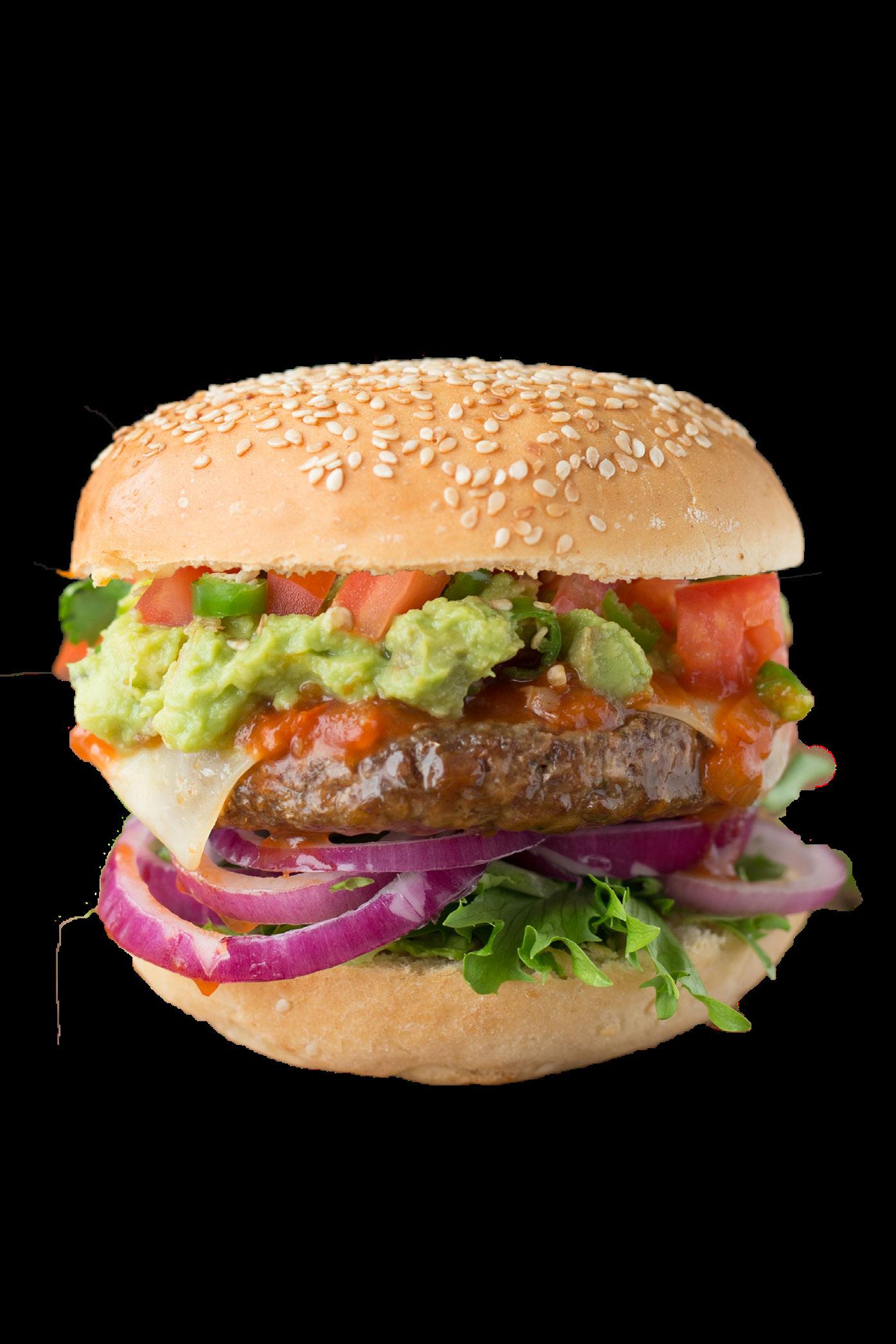
100% plant-based • non-GM naturally cholesterol free and a good source of protein
T h e H i s t o r y o f s a l a d s
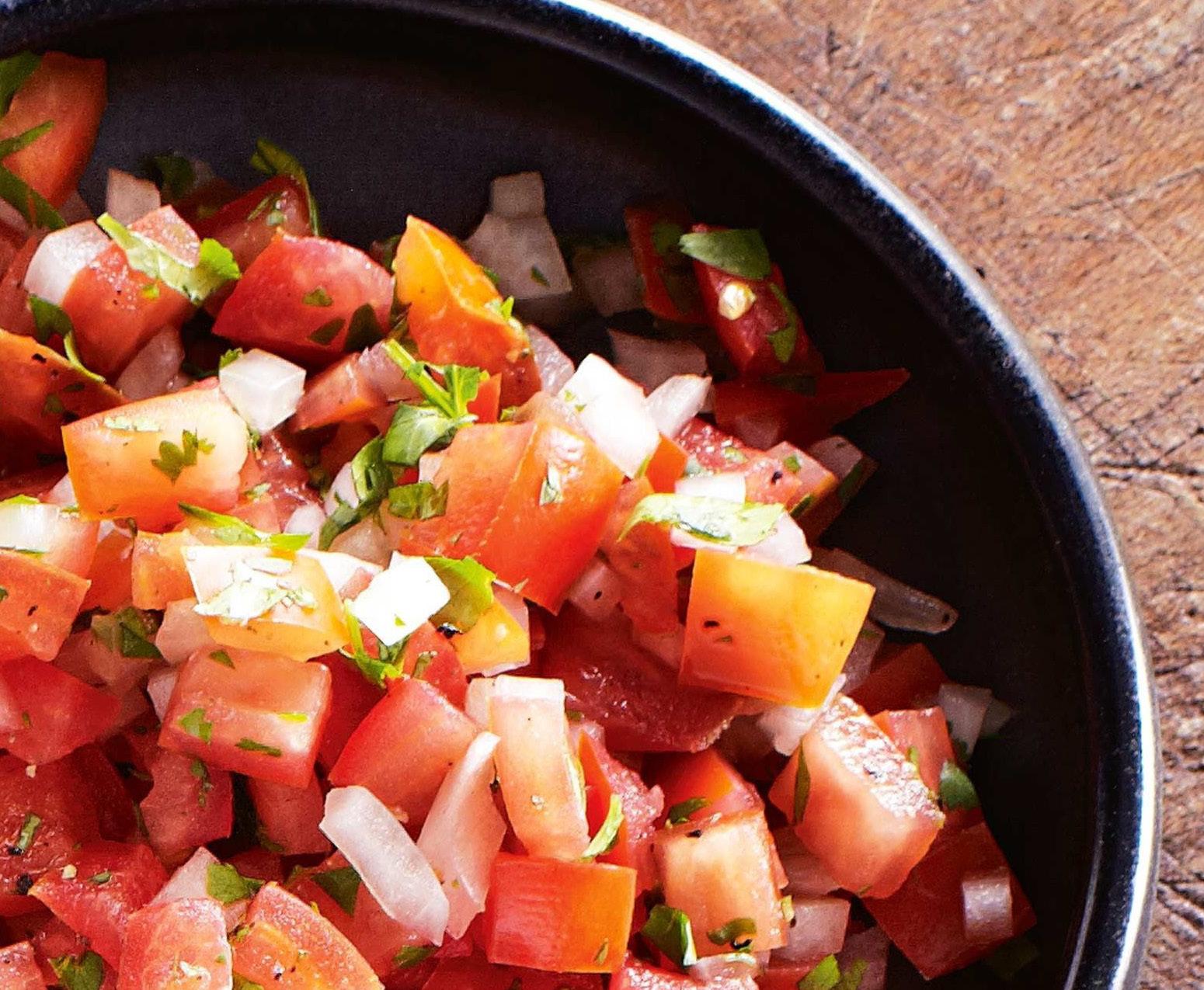
So much about a country and its culture is expressed through its cuisine, and salads happen to form a very big part of South Africa’s food scene. The salads and side dishes South Africans enjoy are as authentic as any home-grown dish.
NATHAN ADAMS & LUTHO PASIYA
THERE IS a rich legacy and history, deeply rooted in the traditional potato salad, coleslaw, sambals, beetroot and three beans dishes.
The manner in which we prepare our salads and the ingredients we instinctively choose are uniquely South African.
Chef and Cape Malay Cuisine expert Cass Abrahams says it’s a history we can be proud of.
“Salads, the way we know them today, were never like this before. They have changed over the years,” she says.
Centuries ago, the African and coloured families in South Africa scoffed at the idea of green salads, and it was not uncommon to hear the expression “Ek eet nie blare nie” (I don’t eat leaves), when they were presented with lettuce or rocket as a side dish.
Abrahams, who is now over 70 years old, says: “I remember when I first tasted wild rocket. It was growing in the garden, and the thought of using it in a salad never occurred to me.”
Over the years, as our needs and grocery lists changed, salads adapted, and some became obsolete.
Slaphakskeentjies was one of the side dishes that hasn’t stood the test of time.
Consisting of pickled onions, eggs, milk or cream and vinegar, it was a staple as a side dish decades ago.
Abrahams is loath to agree that South African salads need to be modernised to adapt to 21st century meals and diets.
“There is still nothing better than a roast, yellow rice and beetroot salad,” she says.
This is a sentiment with which many would agree, because there is a familiarity in the traditional salads that have become staples in South African homes.
A look into local beverages
BY LUTHO PASIYA
TRADITIONAL dishes are known to be seasoned with history. It is the same for the traditional African classics which are known to the African nations as umqombothi (traditional beer), gemere (ginger beer), and pineapple beer.
TRADITIONAL BEER
Traditional beer has always been prepared for purposes where there are celebrations, funerals, or when a family needs to get in touch with their ancestors.
This beer is made from maize, maize malt, sorghum malt, yeast, and water and takes a couple of days to be ready, due to the fermentation process.
Traditionally, it is brewed in a special hut that is not completely thatched so smoke can escape and the beer gets enough oxygen to ferment.
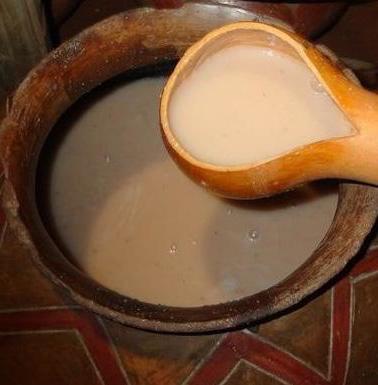
GINGER BEER
Ginger beer which is also known as gemmerbier can be made into a flavoured soft drink or alcohol or non-alcohol beverage. It is made from a blend of ginger, water, and sugar that’s fermented with yeast, then carbonated and bottled.
PINEAPPLE BEER
Pineapple beer is a drink made with fresh ripe pineapple and lime for a healthy, home remedy drink. As South Africa went into lockdown in March, the nation became temporarily obsessed with making beer at home which led to the rise of the pineapple beer. It was by far the most popular, and easy to replicate drink at home. It is a refreshing drink and is non-alcoholic if consumed relatively soon after making, but can pack a punch if left to ferment longer.
Brewing umqombothi is a four-day process that requires maize meal, sorghum, and a catalyst to speed up the process.
DAY 1: Mix equal parts of maize meal and sorghum in a container, add warm water so that it covers the surface to about 3cm. Keep warm overnight. This will allow for primary fermentation and souring.
DAY 2: Cook the mixture to the thickness of porridge and cool overnight.
DAY 3: Add sorghum to cooled porridge and mix until the porridge liquifies. If in colder conditions, add a carton of sorghum beer, keep it in a warm area overnight.
DAY 4: Sieve the fermented beer and enjoy it. | Recipe by brewmaster and founder of Kulcha Konkushin, Palesa Mohale.
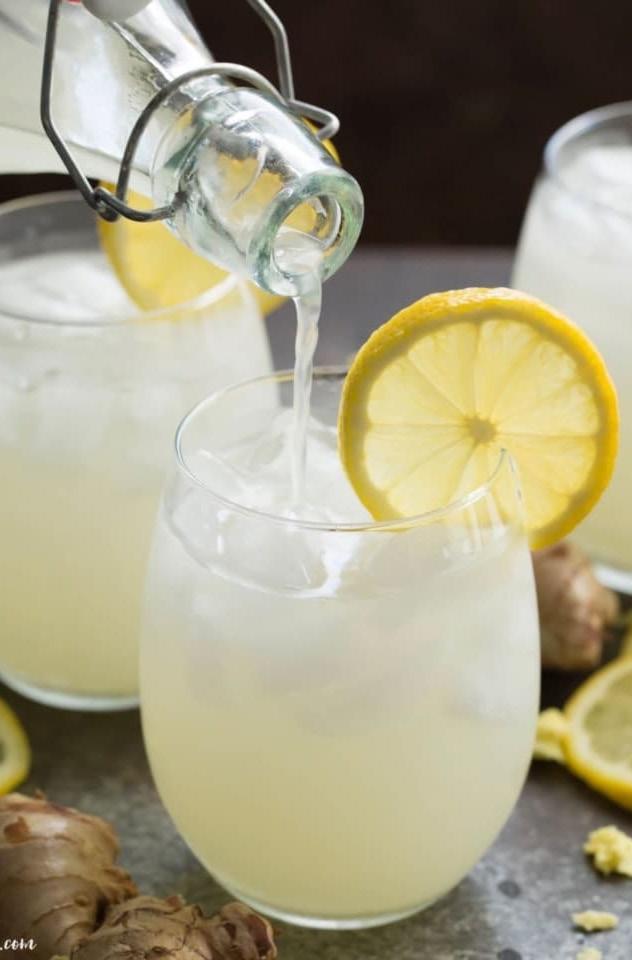
Ingredients:
skin of 1 large pineapple flesh of 1/2 pineapple, chopped into small pieces 7 litres of lukewarm water 2 1/2 cups white sugar 80g raisins 10g sachet instant yeast
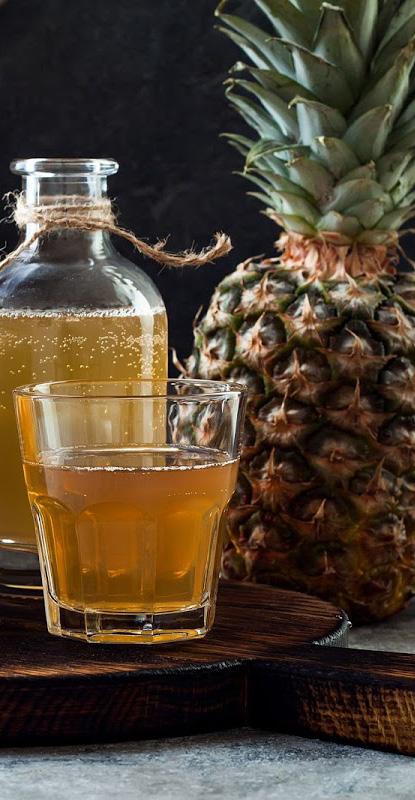
Method: Wash the pineapple skin and chop it into small pieces. Place the chopped skin and pineapple flesh together with the water, sugar and raisins in a large, very clean container. Stir well together.
Sprinkle the yeast over the surface of the water and let it stand for half an hour, then give it a really good stir. Cover it with a very clean cloth and leave in a cool spot for 24 hours.
After that, strain the liquid through a piece of muslin cloth and decant into well sterilised bottles. Balance the lids on the bottles but don’t seal them, and let them stand that way for 12 hours. Seal the caps and chill in the fridge.
Jenny Morris Ginger Beer (Makes 5 Litres)
Ingredients: 4,5 litres water 50g ginger root, crushed 2 1/2 cups white sugar 1 Tbs active yeast (1 1/2 x 10g sachets) 10 raisins (optional) Method: Place the water in a very clean stainless steel saucepan and bring it to the boil. Add the ginger and sugar, and simmer till the sugar has dissolved. Removed from the hear and cool until the liquid is lukewarm. Stir in the yeast and cover the saucepan, leaving to brew for two days. Strain the ginger beer through a piece of clean muslin cloth. Bottle in clean sterilised bottles and, if you are using raisins, place a few in each bottle. Close tightly. Place the bottles in the fridge to chill and consume within a week.
Locally distilled vodkas and gins
SA is on the map as one of the best vodka and gin producing regions. Here’s our list of the home-grown spirits to try. They’ll soon become a favourite
LUTHO PASIYA

VACHELLIA PREMIUM VODKA
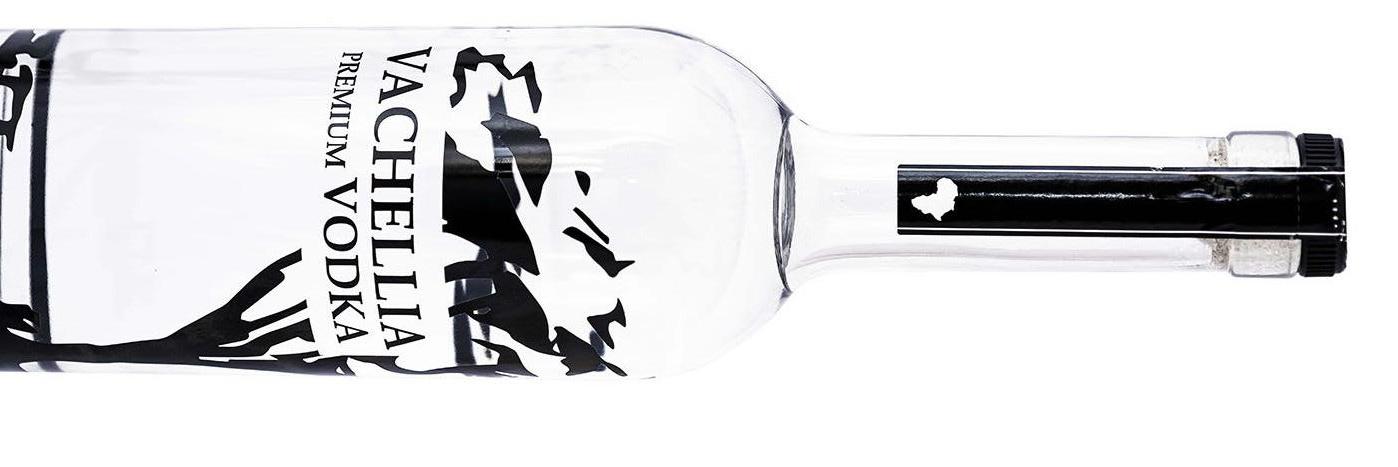
Vachellia premium vodka, founded by Siyabonga Sangquthu and Thabiso Mogodi, is a standard grain-based vodka produced in Cape Town. It’s distilled seven times, left to rest for two days and then bottled at 43% alcohol. It is an incredibly smooth vodka with an unmatched taste. “We wanted to do something different, something that would set us apart from the crowd, something inspiring, relatable, graceful, cultured, and something that embodies Africa and her elegance,” they say. “We wanted to give the world a new taste of Africa... in style, and with luxury at the forefront.”
GR8DIENT VODKA

Gr8dient vodka was co-founded in 2017 by Sakhile Mkhalele and Lesego Tshelane. Mkhalele says the bottle – from the chrome cork closure to the tall slim bottle that towers over its competitors – is a representation of SA’s opulence. “We wanted a bottle that would be bold, eye-catching, and stand tall amongst our competitors. With regard to the design, we went with a gradient effect because we wanted a bottle that tells a story about the process of life, that we go through different shades or phases. Some phases will be brighter or darker than others but at the end of the day, we need to enjoy the process as all the shades shape us.
NATIVE GIN
The Native Spirits brand draws inspiration from SA’s rich culture and heritage of brewing beer and distilling spirits. It pays homage to the native men and women who through the art of distilling, and curated and shaped celebrations over generations. Founder Ashley Moemise says the packaging represents who they are as a blackowned brand. The copper represents not who they are, and the wealth of their people and their land.
“Almost all our botanicals are sourced locally, something we pride ourselves in. The logo is a native Maori face mask showing the Koru lines which represent family and the Manawa lines. It represents one’s life journey – in this case, my personal and entrepreneurial journey and travels. With the botanicals we chose, we were very deliberate in making our flagship, Native gin, a classic silver gin which forms the base of the other two gins that we produce.


